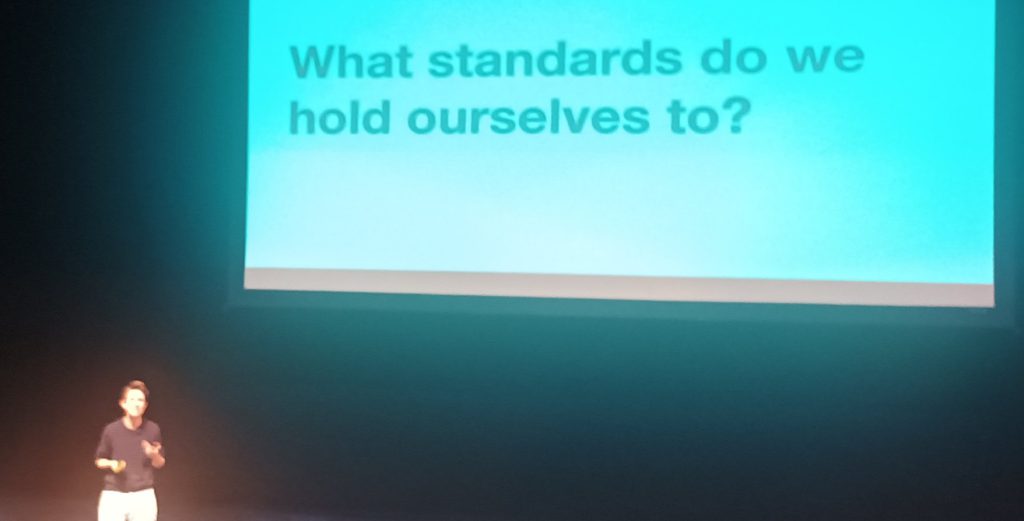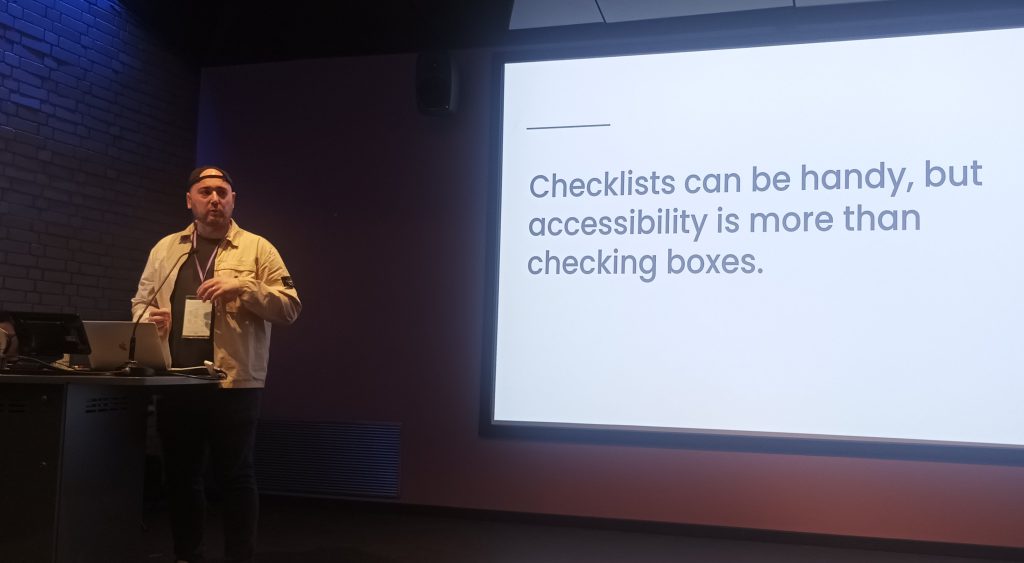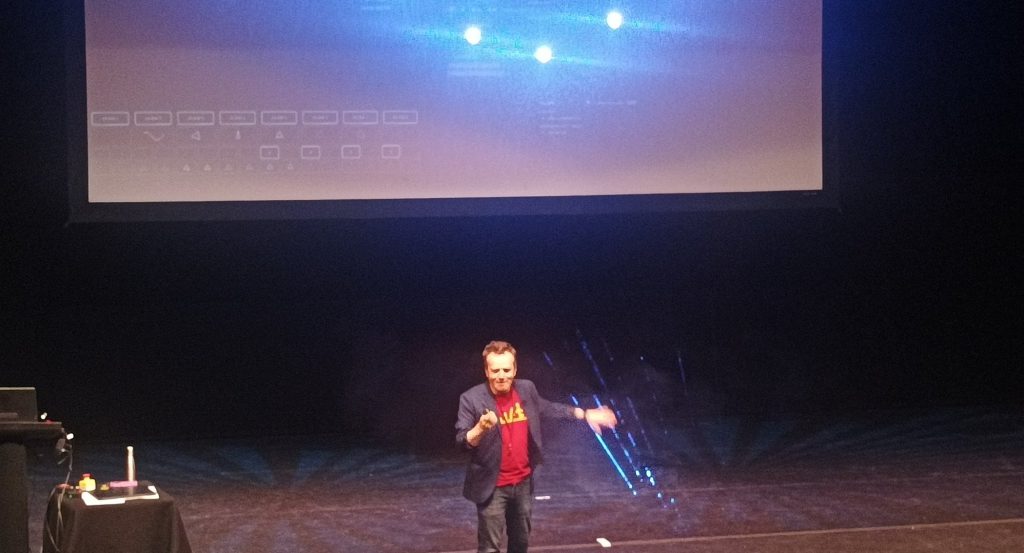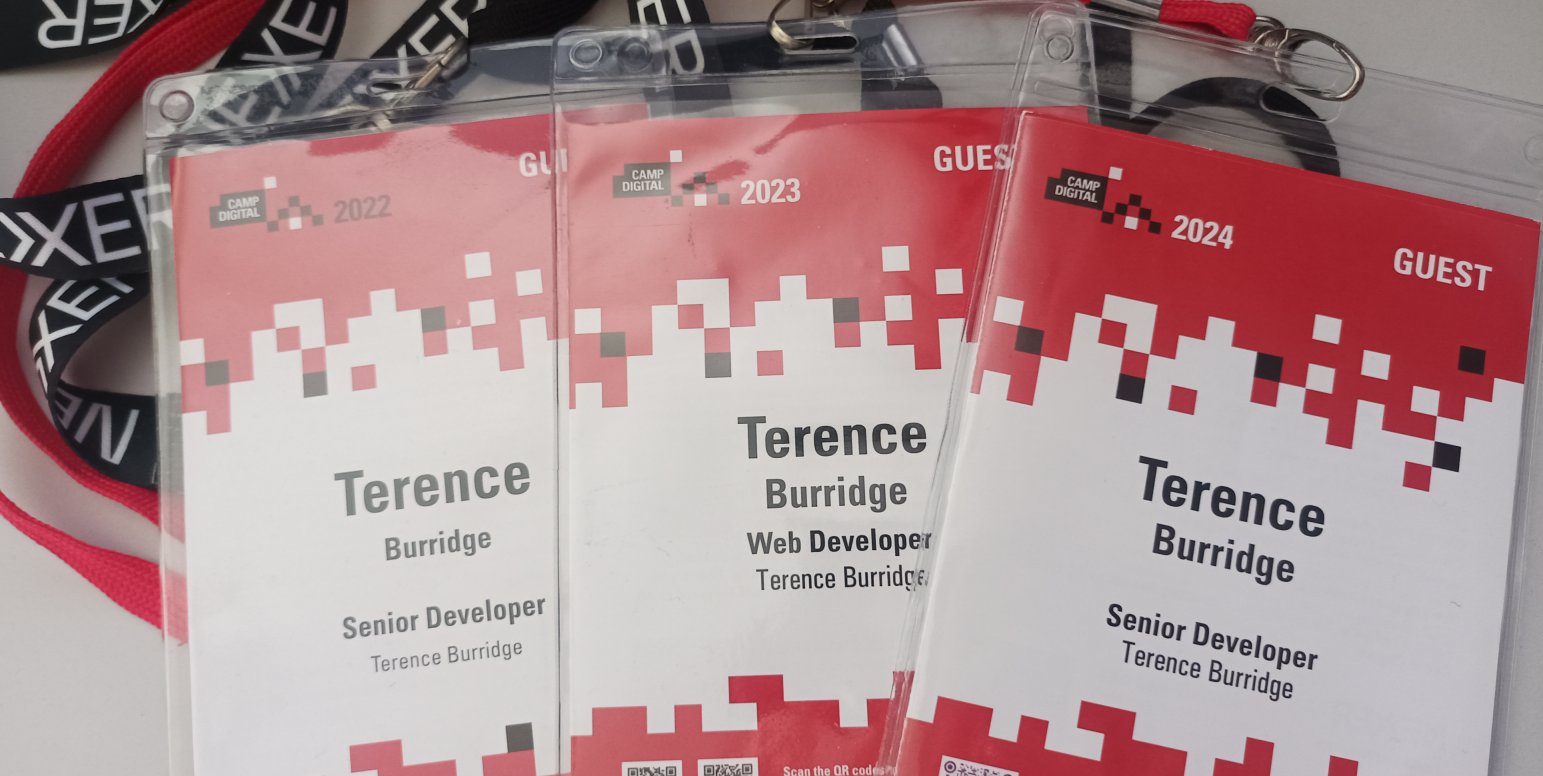Third Year In The Camp
Having only just narrowly missed it in 2020 due to it being the year every event got cancelled, I’ve been keen to get to every Camp Digital held in Manchester since events were able to reopen in 2022. So 2024 marked the third time I’ve been able to get along to CD. I always say this to anyone who asks, but ‘as a developer’ it’s a great event for really getting outside that ‘oh, I just focus only on the code and build the stuff’ box and gaining a better understanding of the why you’re doing what you do – namely for the people! With it having moved slightly earlier in the year to May so now only 2 days after my birthday the previous bank holiday Monday (yes, I was rehearsing my own talks for later in the month on my birthday!), I can also claim this was a birthday treat!
After a successful first year at the new venue of The Royal National College of Music last year, everything returned to RNCM on Oxford Road again for 2024, and once again I managed to wind up there far too early (not quite a month early as my lighthearted social media posts may make out, but definitely still earlier than I needed to). However, I know the area and where to use up spare time very well, so being there so early does leave plenty of breathing space rather than being stressed with rush hour traffic. It also meant I could be through the doors of the venue by about 9.02am, surprisingly finding a large number had already made it even that early in the day. Though that was still only a tiny fraction of the amount who appeared over the remaining hour in time for things to start in earnest at 10am.
Once more Shaun Gomm opened up proceedings by welcoming everyone to the event, in particular thanking so many for managing to make it through despite some challenges on the rail network that week. Before leading us into the morning’s opening keynote speeches all happening on the larger event stage.
The first speaker, Lou Downe, from The School of Good Services, started things off by taking a look at why services fail and how we can make them work. As it’s often helpful to highlight an issue with a real world story, their talk started with an anecdote of where a service really didn’t work, looking at the Uber process for recovering a phone that had been lost in a taxi but required using an app on a phone before having a two factor SMS message sent to proceed. Despite Uber themselves acknowledging one of the most commonly lost items was a phone on blog posts and social posts, they’d made an entire process dependent upon still having it in your posession, something that has thankfully been improved since. This led nicely onto a wider look at the problems with services, highlighting that the law often isn’t going to protect us as unlike with products it is usually too far behind when it comes to services. And making the strong case about many things being designed as noun-based products first (How many of us have had to use that vaguely named ‘MyEPortal’ system in the past?), rather than focusing on the verb or what people were trying to do first. Before covering ways to try and address this by changing this focus and getting everyone to understand ‘why’ we are designing something rather than jumping straight to the ‘what’. You could see why this talk was the first starting topic for the whole day!

After that the second of the main opening talks was from Julian Thompson, asking the question ‘What if Every Digital Team had an Afrofuturist’. Raising a lot of important questions around the racial disparities in modern society. And while we often may think things have changed for the better, as we continue moving to an increasingly digital world the divide actually grows bigger, with biases, practices and standards from one culture posing huge risks to others. But the talk also looked at positive aspects, and how we could improve and make digital much more powerful by including the right people in our teams and having the right conversations at the right times. There were several examples of some more modern technological advancements, such as the use of surveilance or the world’s recent hop-topic AI, but looked at in ways these could be turned around to improve society and reduce disparity. Finishing on the point about how there are great opportunities to use data and technology to create significant change, if only people use them right.
One thing I’ve found with Camp Digital even in my few years here is that with such big topics starting the day, and the split into separate tracks not happening until later, it does feel like lunchtime comes round very quickly, and this year was no different. However, that also leaves a good gap to really process the big topics designed to get you thinking at the start of the day before everyone has to start making those difficult scheduling decisions on which way to split up after lunch (my pro-tip here – if you’re in an organisation which has enough commitment to send a team of three people along, it’s definitely worth getting them to do so as then you can have someone attend every track!).
Myself for the afternoon, I started out with a talk by Ned Gartside from DEFRA on how we might design and deliver greener services. As some of those who’ve read some of my ramblings on this blog over the past few years may know, digital sustainability is a topic that’s definitely close to my heart, so I’m always keen to hear anyone else sharing their thoughts and ideas on this. This talk took a wider look at the impacts of technology, starting off with the more well-known direct impacts such as increased electric usage and the effect that has. But also looking at the secondary impacts, such as planned obsolescence, and new advances such as AI which can come up with new ways of achieving net zero targets, but does so at a huge cost of datacentre usage in itself. After that he started looking at ways things could be improved, with lifecycle diagrams taking a holistic view at systems and processes. I was particularly glad to hear optimising video streams coming up as one of the ideas here too. As I’ve highlighted before having a site which uses video heavily, and has done so since those pre-YouTube 56k dial-up modem days, I’ve always been keen on keeping video data down. But it’s something that has become so overlooked these days due to both the people building the implementations and a high percentage of their most vocal userbase having access to high speed connections. The whole talk ended on a question, and one which would probably be good being pinned to the top of every Kanban board (whether physical or digital) – Can a service be consdered good unless we can be confident it is green?
The next talk on the list I attended was from Michael Gillett at Microsoft, taking a look at the intersection of AI and accessibility. With AI remaing a key topic of discussion within digital, it was almost inevitable there’d be a talk where AI featured heavily, and I was interested to hear a bit of a take on this from someone at an organisation like Microsoft. Things started off with an interesting look at the history of Microsoft’s approach to accessibility over the past 25-30 years, and I’ll admit even I was surprised to see one of their earliest additions Sticky Keys (which I’m sure everyone has managed to turn on accidentally in Windows at some point) having been around since 1994. Before moving on to how some of the new AI technology has been used to introduce new tools such as Copilot and Azure’s Image Recognition services. While I may have already seen a lot of these before, it’s always interesting to hear the angle at which they’re positioned – to try and remove the time required for people to learn how to use software and their interfaces, so they can spend more time on what they’re trying to achieve rather than spending time on the ‘how’ part of this. Once again, trying to make sure the focus is on the people, a common theme throughout the day. To date I still don’t bring much AI into what I do, with not one word of this blog being assisted by it. However, having a site with over 40,000 images on, I do hope one day I can use AI to facilitate viable alt-text tagging for improving accessility at such large scale. As these are very design graphic-heavy images rather than the more typical ‘objects’ or ‘scenes’ which most recognition currently seems to be geared towards, I’ve not yet managed it, but I certainly keep track on how this technology advances.
This focus on people led nicely into the next talk I went along to from Shaun Conner, with the teasing title ‘So you’re compliant; now what?’. While WCAG, or Web Content Accessibility Guidelines, are very well known by now within the digital accessibility space, this talk raised a point about whether in some ways these well meaning guidelines are causing unintentional problems. During recruitment for people, it was common to find themselves inundated with people who would talk about all the technical compliance they’d done, but with little focus on the people side of things. A valid hypothesis was raised that a lot of this may be down to people coming from traditional development backgrounds. But was this also then acting as a spiralling barrier as the people who might look at things from the human side may be deterred fearing they didn’t have the technical compliance skills? When in reality, hitting those technical ‘checklist’ style audits are only a tiny fraction of a much bigger picture. People who’ve read my frequent references to the overzealous focus put on arbitrary scores from Google Page Insights too will know this is an issue I consider to go much wider than just the A11y checklists, but the focus here was on the accessibility side of things. After looking at some of the problems, Shaun also moved on to better ways to address and try and move beyond this, by shifting left and bringing people in earlier. Encouraging everyone to always be asking the question ‘who might this be excluding’ and doing research with real people by putting them in front of something as early as possible. But also ensuring everyone on the team is invested long before the implementation phase, by including them in workshops, talks and assistive technology training so they have a better understanding of the ‘who’ rather than the ‘how’. Yes, you may have noticed me repeating variations on that line a lot in this post, but that’s because it’s a topic that underpins Camp Digital so much! Towards the end there were some very interesting points raised on how to interpret statistics too, and use them for better, looking at numbers showing much higher percentages of people using assistive technologies compared to the statistics on people with accessibility needs. Making the point it’s a bad assumption that you’re doing this just for users with disabilities, as people will use different tools in different ways for many reasons beyond your initial assumptions. It was quite fitting given I’d only just recently tweeted about the live captioning available at the event. If taking an overly simplistic view it’s easy to think such live captioning is only there for people hard of hearing, but I was using them myself frequently too. During a busy talk it’s very easy to miss a point or for a slide to be moved on before you’ve picked up an important detail from it. So still being able to see live captions of what had just been spoken for a few minutes afterwards provided a second chance to pick up on points that could otherwise have been lost. A great example of an ‘accessibility improvement’ benefitting everyone!

The final talk of the split track for the day I went to was from Rachel Morgan-Trimmer, with the deliberately slightly provocative title ‘How to Exploit Autistic People*’. The asterisk being included in the title too as part of the caveat that yes it’s a joke and we weren’t really going to be exploiting anyone, but instead it can be looked at that really we’re looking at ways of improving neurodiversity inclusivity. Rachel started off with some real life examples of how roles had restricted being able to do the best work, as well as giving examples of silly things people have said in the past when finding out someone is autistic. Before moving on to provide a wealth of statistics on just how much of a boost to productivity, profit and retention within businesses autistic people can bring. There were some good examples of simple improvements to the workplace that could be made, such as making sure people have easy access to toilets, food, or different environments better suited to them. More than anything the theme was around just talking to people and seeing what you could do to make the work environment as enjoyable as possible for the individual, as ultimately happy people can focus on what they enjoy and do better. Advice which should really apply widely across all businesses, but which I know businesses can often get so wrong. There were certainly some very powerful and emotional moments to this talk, before it finished once more on a ray of hope that doing the right things can help chip away at sadness to make things better for all.
After such a moving talk, it was definitely good to have another brief break to breathe, before everyone came back together for the final keynote of the day. As is traditional with Camp Digital, this was the more fun and creative one to finish off what has by this point usually been a whirlwind of serious and thought provoking discussions. Seb Lee-Delisle took us on a whistlestop tour of their journey into large scale public laser displays. Starting out with his earlier coding days creating flash games which, though often underappreciated at the time due to a younger target audience, nowadays have grown into well known memes as people have aged. Then moving on to how they worked into pyro-technical displays, before finally moving into laser work. Everyone always loves a live demo of code, but a live demo of code with an actual powerful laser in the room is something you don’t very often see, and Seb was keen to reassure everyone he had good public liability insurance here! The ultimate ending point of this was showing lasers being used to recreate famous vector based arcade games such as Asteroids and Lunar Lander, just done with a large laser and audience participation. Among all this fun, there was still a serious message at the end, with a call to try and bring more diversity into the laser show industry too by promoting schemes to try and bring new people in from underrepresented groups. Overall a fantastic way to finish off another great day, and Camp Digital for another year. I can’t say anything with certainty these days for reasons many people already know, but I definitely look forward to being able to return to Camp Digital in 2025.

As with last year, with the conclusion of the main event, many of us once more moved round the corner to unwind and talk about the experiences of the day at the afterparty at Brew Dog on Oxford Road. I worry slightly I’ve gone too far into that phase of life now when I still remember this all too well as a Blackwell’s book store rather than a bar, but that’s by the by. I’m not usually a one for the long social evenings, especially after having been on the go since 6am that day, but I was able to hang round for a few more hours to enjoy a lovely mix of topics. From delving into serious discussions on development and current political issues. To showing my lack of popular cultural knowledge with games of Articulate. Certainly a great way to finish off a long day!
I cannot say it often enough, but thanks should go out once again to everyone involved in bringing Camp Digital together. The team at Nexer. The Royal National College of Music for having a great space. All the partners supporting the event. The speakers, for giving us all those great angles. The stenographers sat away quietly unnoticed in the background keeping all that live captioning going! And of course all the attendees for making such an effort to turn up each year, especially when it has been a battle with some last minute travel disruptions. It’s a lot of work to bring together, but every year results in an event which can make Manchester proud!


